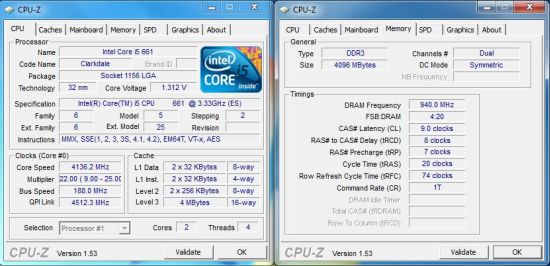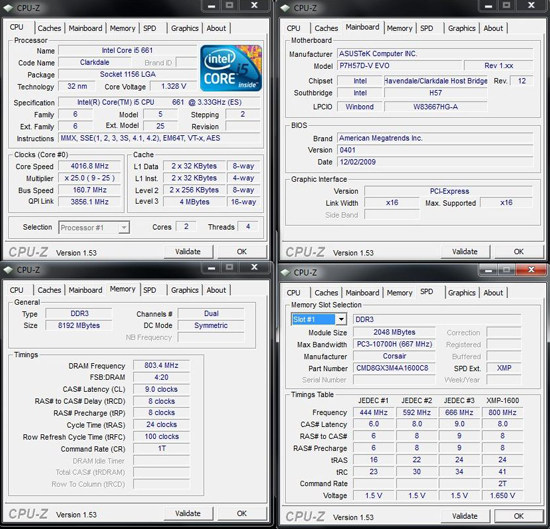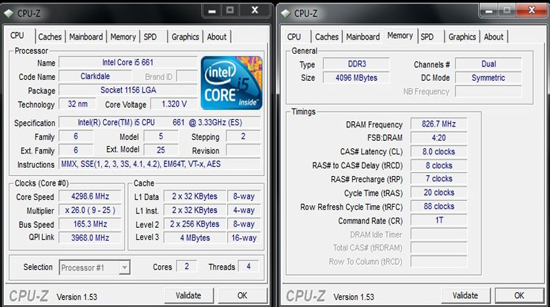Choosing the Best H55/H57 Motherboard - Part 1
by Rajinder Gill on January 31, 2010 11:30 PM EST- Posted in
- Motherboards
Overclocking - Dissent in the Ranks
Ok, let's start off with a discrete GPU. When using 4GB configurations, the best board of the bunch appears to be the ASRock.

It's the only board that manages this speed fully stable with our Corsair Dominator kit. This is surprising considering the ASRock board has the least overclocking centric BIOS of the boards we have on test today. Voltage scales are fairly coarse in stepping, and memory sub-timing options are limited together with control over the QPI multiplier, but this does not seem to affect the board when it comes to 4GB memory configurations using the 2:10 memory ratio, even when using "lesser" performance modules.
The H57 EVO manages to take the same components to around 182 BCLK while the MSI and ASUS H55 models reach their limits at around 175 BCLK - around 130MHz lower than the ASRock board for raw memory frequency.
8GB memory overclocking is a different story. The leader in this department is the most expensive board on test today, the ASUS H57M EVO:

ASUS' H57 offering pips the ASUS H55M EVO to the post with our 8GB Corsair memory kit. The H55 model manages around 1580MHz fully stable vs. 1600MHz stable on the H57.
The ASRock's limits come in around 1450~1500MHz because you don't get access to some of the sub-timings needed to run higher memory speeds fully stable when the DIMM slots are loaded with 8GB, nor do you get the option to lower the QPI multiplier. That lands you at frequencies that the IMC cannot handle when loaded heavily.
MSI's BIOS provides plenty of additional sub-timing options, although we could not find a combination of settings to help achieve what we managed on both of the ASUS boards using the same memory modules. The QPI ratio had to be dropped to accommodate, while memory sub-timings needed loosening to achieve full stability.
One thing worthy of mention here, S3 sleep resume will work on the ASUS H55/H57 EVO boards and the MSI board at 200BCLK and beyond if you use lower memory multiplier ratios and QPI multipliers. The ASRock H55M-Pro is limited to a maximum of 190 BCLK for sucessful S3 resume on current BIOS releases.
Overclocking with the IGP Active
This is where things become limited rather quickly when it comes to maximum stable BCLK frequency. Anything over 165 BCLK needs judicious amounts of IGP voltage to facilitate higher CPU core speeds, even if you don't overclock the IGP in tandem. Using our 661 sample CPU and retaining the stock 900MHz IGP frequency, a BCLK of 165 is possible on all four boards using the 2:10 memory ratio and the highest available QPI multiplier. Anything higher and we have to pump an extra 0.1V into the IGP to get to 175 BCLK.

One would think that using a lower the QPI multiplier and memory ratio would increase headroom somewhat, but it appears this is not the case. We tried all QPI multipliers in conjunction with the 2:8 and 2:6 memory ratios and could not find a combination that was stable enough to enter the OS over 175 BCLK. Whether or not this is down to vendors getting to grips with the platform or not is currently unknown to us, although it would not be surprising if that happens to be the case. Time will tell.
We've run out of time to explore every angle of IGP performance and QPI ratios in this article, but we will endeavor to cover this angle in a future article if need be. Right now, we'll say it appears that you're going to be BCLK limited south of 170 MHz with the IGP in tow. Subtract another 20MHz off that for 8GB configurations, and bear in mind that you'll need to use low memory speeds, capping you to a maximum of around DDR3-1333MHz with things in their current state.










56 Comments
View All Comments
crochat - Wednesday, February 3, 2010 - link
In my opinion testing H5X boards should focus on IGP. Isn't that the aim of the chipset to use CPUs with IGP? Instead of the gaming benchmarks I'd be much more interested in multimedia and peripheral (firewire, esata, usb, networking) performance.Regards
thorgal73 - Tuesday, February 2, 2010 - link
Just to let you know, Massman found the solution to the IGP overclocking problem :http://www.madshrimps.be/?action=getarticle&ar...">http://www.madshrimps.be/?action=getarticle&ar...
Cheers!
Rajinder Gill - Tuesday, February 2, 2010 - link
Thanks for the link.That actually makes a lot of sense and explains the extra IGP voltage you have to pump - even though BIOS shows a fixed IGP freqeuncy.
Probably a good idea just to make it into an Excel calc so people can use it easily.
http://www.mediafire.com/file/2go0yotyz5z/quick">http://www.mediafire.com/file/2go0yotyz5z/quick igp calc.xlsx
later
Raja
Rajinder Gill - Tuesday, February 2, 2010 - link
This one's a bit better, easy to work out the required BCLK for and equivalent IGP frequency at various IGP multiplier ratios.http://www.mediafire.com/file/nhfnnedgzwb/quick">http://www.mediafire.com/file/nhfnnedgzwb/quick igp calc.xlsx
yuhong - Monday, February 1, 2010 - link
"If you're going to use the IGP, you don't really need the extra PCI-E lanes, which essentially means that you're paying for the option to run RAID on the H57 PCH. "Well, USB 3.0 and SATA 6GBps takes 4 PCIe lanes.
Rajinder Gill - Monday, February 1, 2010 - link
You're looking at $200 boards that offer both SATA 6G and USB 3.0 in tandem unfortunately. USB 3.0 can be had under $130, with enough PCI/e left over for upgrading IMO.Nataku - Monday, February 1, 2010 - link
Just wondering (may be I'm just being dumb)Do you know if any or all of the h55 boards support dual screen?
I've been wanting to build a HTPC and dual screen it with my TV and a touch screen, but wasn't sure if the video out can actually work in dual screen mode.(ran into one that only ran in clone long ago =.=)
Also, this is off topic but, will you guys be making some reviews on touch screen monitors? HP and Dell are selling 20"+ touchscreens at around 300CAD but Firebox and Elo are selling 15" at 4~500CAD. Just curious how that part of the industry are coming along (20" too big imo to be beside a TV...)
Rajinder Gill - Monday, February 1, 2010 - link
Hi,Yes, dual display options are offered as part of Intel's drivers for the IGP. So you should be able to setup both options. I've tried with DVI and HDMI outputs simultaneously and it recognises both fine and allows you to set them up.
Jarred's the guy for monitors and such, so I'll pass the info over to him.
Hope this helps..
Raja
Nataku - Thursday, February 4, 2010 - link
Thanks :)Rick83 - Monday, February 1, 2010 - link
I am currently looking to upgrade my server and the savings from replacing the old nv 6200 with on-chip graphics are attractive.Now, normally this would be a done decision, but I am planning on running quite a few drives in that box, 14 to be precise. Currently I have one RAID 5, one RAID 1, one root disk and one optical drive, I will add another RAID 5 and another RAID 1 as part of the upgrade. All except 5 drives are attached via SATA. I already have an IDE-controller installed via PCI, but I'd like to avoid installing an extra SATA controller, as it seems much cheaper to just go for a board with 10x SATA on board.
But due to my use of full-disk encryption, I'd really like to be able to access AES-NI, so it will have to be a clarksdale i5. There are P55 boards with 10 SATA ports, and X58 boards too, but I'd really like to go with the on-chip graphics, both to save what little pci-e I have on these boards, as well as to save the space and energy.
Does anyone reasonably expect Asus or Gigabyte or MSI (as those are the usual suspects for 10x SATA) to release such a board based on H5x? If not, I'd best grab an old Gigabyte P55 UD5 soon...